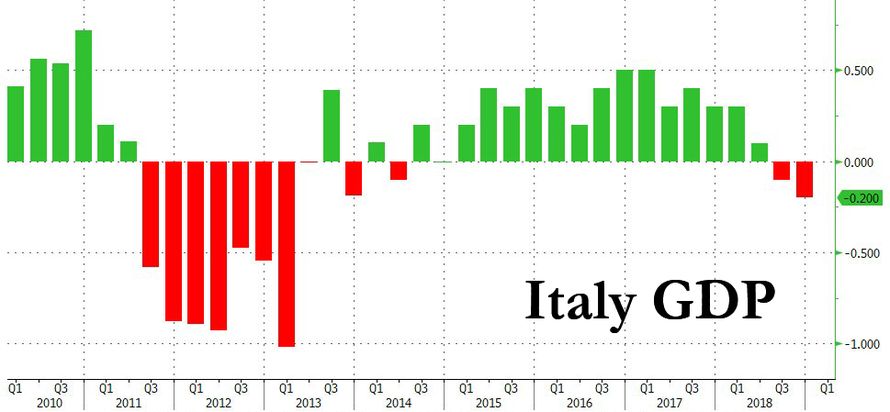The Italian government’s decision to cut its growth forecast for 2019 to just 1% during the most heated period of the populist government’s budget battle briefly rattled investors in the country’s bondholders. As it turns out, even that number may have been too optimistic.
In a report that could once again test the market’s confidence in Europe’s third-largest economy, official data from Italy’s Istat revealed that Italy’s economy fell into a technical recession during Q4, as economic output shrank 0.2% in the three months through December, following a 0.1% decline during the previous quarter.
News of the recession will further strain the relationship between M5S and the League, the two parties which make up the populist coalition that has been running the country since elections in March 2018. The populists had been riding high after striking a budget deal with the EU that allowed Italy to blow out its budget deficit far beyond the 0.8% of GDP that Brussels had initially demanded. Lately, Deputy Prime Minister Matteo Salvini, the leader of the League, has been facing internal pressure to call for early elections as the League’s poll numbers climb – largely thanks to the party’s anti-immigrant stance. The goal would be to push out the increasingly unruly M5S, allowing the League to take unilateral control, potentially in coalition with Silvio Berlusconi.
In a rapid response to the numbers, analysts at Goldman Sachs said they believe there’s room for even more pessimism than the official numbers would suggest:
- Italian GDP growth was -0.2% (non-annualised) in Q4, weaker than consensus expectations of -0.1% and the pace of growth seen in Q3 of -0.1%. The print confirms that the Italian economy is in a technical recession.
- The breakdown of the GDP components is not available and will be released on 5 March.
- With Q4 data in hand, calendar-year growth for 2018 was +0.9%, down from +1.6% in 2017. Today’s GDP print takes calendar-year growth for 2019 to 0.2%.
- The balance of risks to our GDP growth forecast for Italy is to the downside. Our 0.2% calendar-year growth forecast for 2019 is based on a sizeable acceleration in activity in 2019H2. But given falling business confidence, tightening bank credit standards and continued political uncertainty, this looks less likely than we thought a few months ago.
- The weak economic outlook poses a challenge for the government to meet its public finance targets. We remain more pessimistic than the official forecast on the outlook for the government deficit and public debt, and expect another volatile year for the Italian economy and Italian asset prices.
There are other signs that the government’s official forecast from its budget model might be unreasonably positive: both the Bank of Italy and the IMF project 0.6% growth in Italy this year, less than half the forecast pace of the 19-nation euro zone.
Unfortunately for Mario Draghi and his hopes for unwinding the European Central Bank’s massive stimulus program, Italy isn’t the only major European economy experiencing a marked slowdown. Fears of recession have also been dogging Germany following a plunge in industrial production last month.
via ZeroHedge News http://bit.ly/2G117gt Tyler Durden
